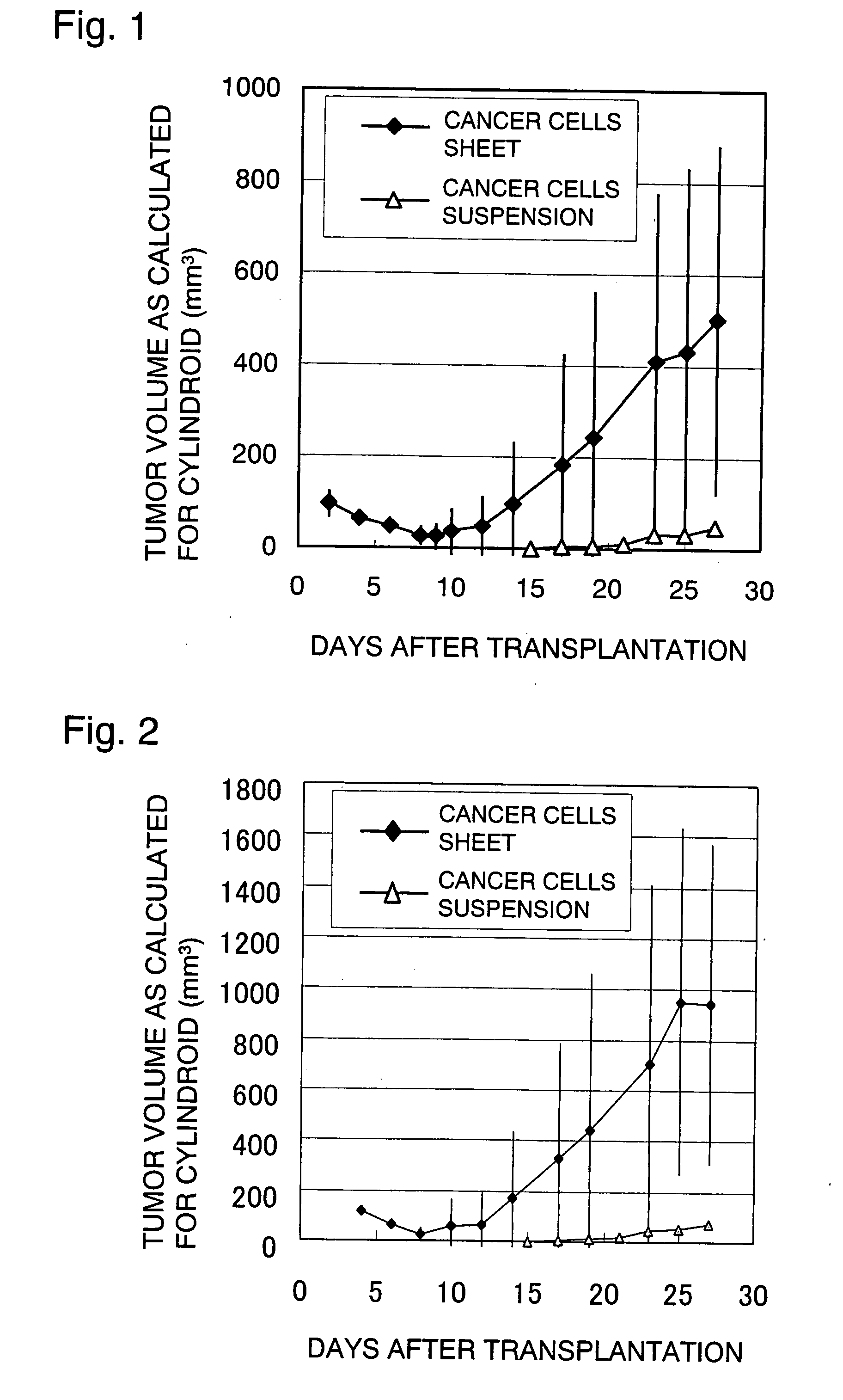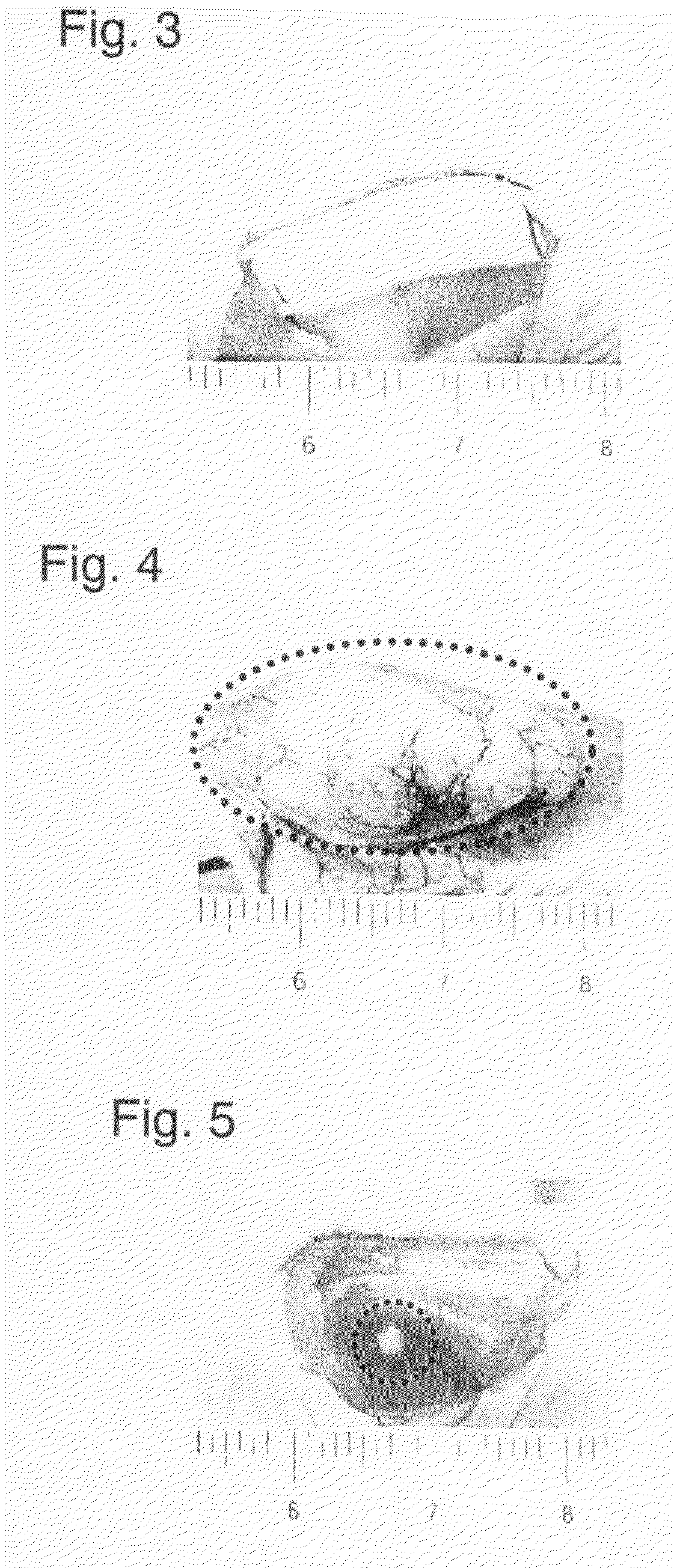Method of Constructing Animal Having Cancer Cells Transplanted Thereinto
a cancer cell and animal technology, applied in the field of can solve the problems of difficult adoption, long time, and high cost, and achieve the effect of efficient preparation of cancer cells transplanted animals
- Summary
- Abstract
- Description
- Claims
- Application Information
AI Technical Summary
Benefits of technology
Problems solved by technology
Method used
Image
Examples
example 1
[0032]A cell culture base was coated with the temperature-responsive polymer poly(N-isopropylacrylamide) in an amount of 2.0 μg / cm2 and the cancer cells NCI-H460 was cultivated (2×104 cells were seeded; 37° C. in 5% CO2). Three days later, the cancer cells (NCI-H460) on the culture base were confirmed to have become confluent; thereafter, a cultured cell moving jig comprising a polyacrylic plate coated with a fibrin gel was gently placed over the cultured cell sheet so that the cultured cancer cells adhered to it; then, the cell culture base was cooled at 20° C. for 60 minutes. After the cooling, the detached cell sheet was collected from the jig together with the fibrin gel and a piece of the gel with the adhering cell sheet (7 mm×17 mm×2 mm; 5×105 cells) was transplanted subcutaneously to the back of each of 10 nude mice. The dimensions of the tumor that developed after the transplantation were measured over the skin with a micrometer and the results obtained by calculating the vo...
example 2
[0034]A cell culture base was coated with the temperature-responsive polymer poly(N-isopropylacrylamide) in an amount of 1.9 μg / cm2 and the cancer cells A-549 was cultivated (2×104 cells were seeded; 37° C. in 5% CO2). Three days later, the cancer cells (A-549) on the culture base were confirmed to have become confluent; thereafter, a poly(vinylidene difluoride) [PVDF] membrane not coated with a fibrin gel was gently placed over the cultured cell sheet so that the cultured cancer cells adhered to it; then, the cell culture base was cooled at 20° C. for 60 minutes. After the cooling, a sheet of cancer cells (7 mm×17 mm×2 mm; 5×105 cells) was detached together with PVDF membrane. The back of each of 10 nude mice was incised linearly beneath the skin and the subcutaneous tissue was detached with forceps to create a pocket, into which the above-described cancer cells sheet was inserted. After the inserting, the incised part was sutured to complete the transplantation. The dimensions of ...
example 3
[0035]The cancer cells transplanted animals prepared in Example 2 were administered a total of four times on a once-a-week basis with 3 mg of 5-fluorouracil (5-FU), a known anti-tumor agent, through the tail vein as it was dissolved in 0.3 ml of 1% ethyl alcohol containing physiological saline. Four weeks after the administration, the mean volume of ellipsoid was 279.6±127.1 mm3, the mean volume of cylindroid was 619.3±262.9 mm3, and the mean tumor weight was 369.3±123 mg. As it turned out, the cancer cells transplanted animals described in the present invention got the volume and weight of the tumor to be reduced by receiving the anti-tumor agent. Obviously, the cancer cells transplanted animals of the present invention are useful in selecting an effective anti-tumor agent.
PUM
| Property | Measurement | Unit |
|---|---|---|
| temperature | aaaaa | aaaaa |
| critical temperature | aaaaa | aaaaa |
| temperature | aaaaa | aaaaa |
Abstract
Description
Claims
Application Information
 Login to View More
Login to View More - R&D
- Intellectual Property
- Life Sciences
- Materials
- Tech Scout
- Unparalleled Data Quality
- Higher Quality Content
- 60% Fewer Hallucinations
Browse by: Latest US Patents, China's latest patents, Technical Efficacy Thesaurus, Application Domain, Technology Topic, Popular Technical Reports.
© 2025 PatSnap. All rights reserved.Legal|Privacy policy|Modern Slavery Act Transparency Statement|Sitemap|About US| Contact US: help@patsnap.com



